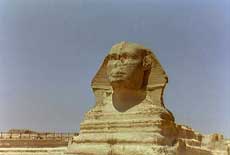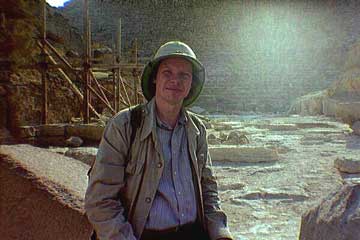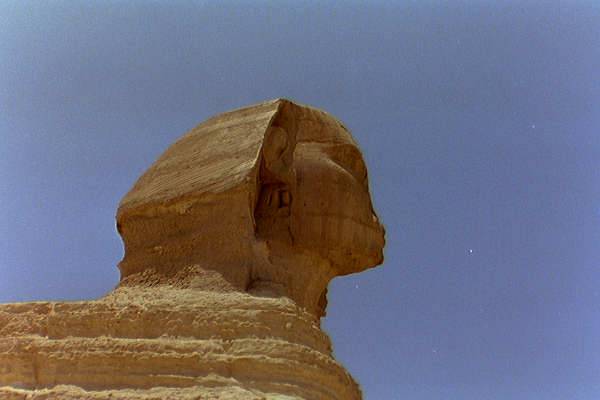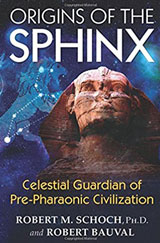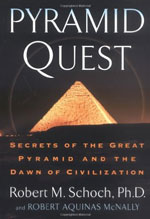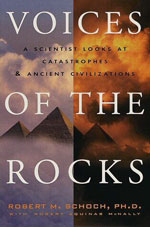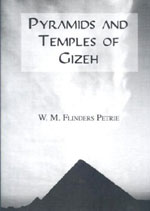
The Great Sphinx Dating Debate
–
Page Five
text translation service for many worldwide languages
Comments by Robert M. Schoch on the Geological Analysis of Ian Lawton and Chris Ogilvie-Herald
found in chapter 7 (“The Age of the Sphinx”) of
“Giza: The Truth”.
[ by Robert M. Schoch. All rights reserved]
Dr. Robert M. Schoch continues the debate
…
“Origins of the Sphinx:
Celestial Guardian of Pre-Pharaonic Civilization”
by
Robert M. Schoch Ph.D.
and
Robert Bauval
Get This Book From:
Amazon.com
Amazon.co.uk
Today is
|
|
“Regarding these so-called “faults”, the geologist David Coxill (writing in the journal “InScription: Journal of Ancient Egypt, Issue 2, Spring 1998, page 14” another article that Lawton and Ogilvie-Herald fail to cite) notes: “The sub-vertical joints . . . are a distinctive characteristic of the surrounding pit [that is, the Sphinx enclosure], and to a somewhat lesser extent, of the Sphinx itself. They are natural fissures in the rock, that were formed by contraction of the carbonate rich sediments, when they were undergoing rockification. These are sedimentologically related fissures and not tectonic faults related to earthquakes, since they do not displace the strata. On the . . . Causeway edge, they are sometimes closed and grouted by fine grained carbonate sediments [a natural process], while others, are open at the top, narrowing, and eventually closing – – further down the vertical profile of the excavated pit face, and the sphinx’s body . . . They represent lines of weakness that have selectively and progressively been exploited by the forces of weathering.”
It is worth quoting Coxill (pages 16-17), an independent geologist who has taken the time to study the Sphinx first-hand, further on these issues:
“[Robert Schoch] presented his findings . . . that the weathering features present [on the body of the Sphinx and in the Sphinx enclosure] are caused by rainfall that has cascaded over the sides of the monument and the surrounding pit …
Other theories have been put forward to try to counter the claim. Lal Gauri et al. (1995) consider that being porous, Member 2 limestone [of which the body of the Sphinx is carved], will suffer from morning dew condensation that dissolves salts within the limestone. When the heat of the day evaporates the water, the salts crystallise out and progressively exert minute pressure weakening the rock and opening up fissures already present.
Both they, Hawass, and Lehner (1994), suggest that sub-surface water movements, during Eocene times, caused the fissures to open as the water table dropped. This is intriguing, but unlikely to be the case. Firstly, condensation affects all monuments in the Giza complex, but very rarely do any show the same type of weathering features of the Sphinx, surrounding pit and cut stone blocks of the Valley Temple.
Secondly, these weathering features require intense weathering to form their present profile, and, condensation/evaporation is a relatively mild and insignificant form of mechanical weathering in this arid climate.
Thirdly, fluctuations in the water table do not lead to fissures being produced wider at the top. Lal Gauri [et al.] (1995) also suggest that the roundness of the laminars is due to gradational differences in the hardness of the strata. This does not account for variations in the weathering profile, within Member 2 beds, as previously discussed on the Sphinx’s body or the presence of open fissures.
Harrell (1994) suggests that wet sands from Nile floodwaters, and occasional rainfall, would have produced wet sands, leading to these weathering features. That is not acceptable, since floodwaters would have produced a wave cut bench and notch, which would certainly be seen today in the surrounding excavation pit. This is not the case, and again this theory does not satisfactorily explain the presence of erosion features higher up the Sphinx’s body and pit face. . .
Therefore, by a process of elimination, it appears that floodwaters and fluctuating ground water levels cannot explain these weathering features, but rainfall does.”
Bottom line: Coxill, an independent geologist (as of this writing, I have never met him nor corresponded with him), corroborates my analysis of the nature and agency responsible for the predominant weathering and erosion seen in the Sphinx enclosure and on the body of the Sphinx.”
|
|
a selection of books about
Ancient Egyptian Mysteries
Prints & Posters of Ancient Egyptian Art |
Ancient Egyptian Mysteries Bookshoppe
please take a look at our Ancient Mysteries Bookshoppe for a wide selection of books
that challenge orthodox views of prehistory on every continent
|
|
2019 Skywatching Calendar |
News & New Discoveries |
Marine Archaeology News 2019 |
Astro-Archaeology News 2019
The Morien Institute
